A chronology of events in 1942.
January 1942
Malta
14 January – On this day alone, Malta receives 14 air raid alerts in 19 hours. A total of 262 air raids are sounded in Malta in January.
Libya
21 January – From his base in El Agheila, Rommel’s Axis forces take Agedabia and Beda Fomm.
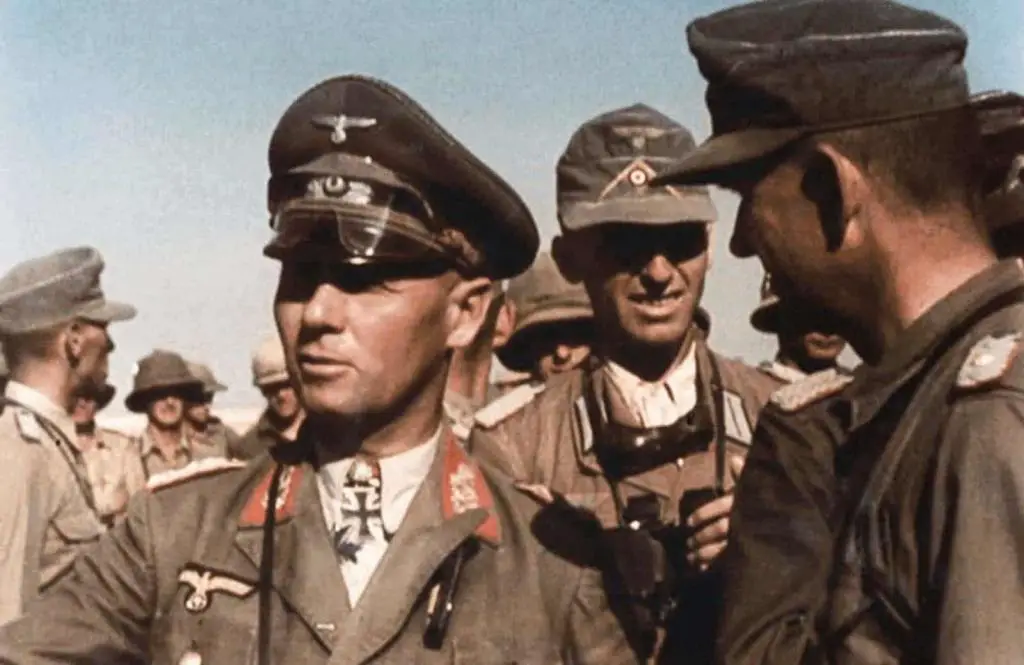
A 1942 color photograph of Erwin Rommel (L) and his staff in North Africa.
23 January – Italian intelligence begin giving Rommel the daily British Order of Battle. Italians give the Marcks Group more power by presenting the self-propelled Semovente 75/18.
29 January – Rommel’s Axis forces enter Benghazi and acquire 1,300 trucks.
February 1942
06 February – The British are pushed back to Gazala. The British Commonwealth forces lose 40 tanks, 40 field guns, and 1,400 troops. This was a disaster for the Allies in more ways than one. Now the Allied convoys to Malta must pass between Axis occupied Crete and Axis airfields in Benghazi.
Malta
07 February – Malta had 17 air raid alerts in a span of 24 hours. By 25 February, a span of 80 days had accumulated in which the island has been on continuous alerts. A total of 236 air raids were sounded in Malta this month.
Force K, the British naval unit assigned to Malta, had been reduced to the Penelope and three destroyers. With this limited protection, Italian convoys were able to supply Rommel’s Axis forces in Africa. On occasion, these convoys are escorted by the Italian battle fleet, but usually by Italian heavy cruisers.
13 February – Italian torpedo boat Circe sinks British submarine HMS Tempest off Taranto.
15 February – Ugo Cavallero and most Italian military personnel become worried that Rommel may compromise the planned invasion of Malta. Rommel flies home to Germany to convince Hitler to overrule restraining orders set on him by Ugo Cavallero and Kesselring.
25 February – Italian destroyers sink British submarine P38 off the coast of Tunisia.
March 1942
Kenya
3 March – Prince Amedeo of Savoy, 3rd Duke of Aosta dies in a Nairobi, Kenya hospital after suffering complications from Malaria and Tuberculosis.
Second Battle of Sirte
22 March – Admiral Iachino sets sail in his flagship, the Vittorio Veneto, along with 2 heavy cruisers, the Gorizia and Trento, light cruiser Bande Nere and four destroyers to intercept a convoy.
The convoy is protected by three fast frigates, along with the Clan Campbell, the Pampas the Norwegian Talabot, the Breconshire, the Carlisle, and six destroyers. The Penelope and destroyer Legion join them.
At 9:30 A.M., Italian torpedo bombers began the attack on the convoy and its escorts, causing no damage. The Luftwaffe then appeared and again no damage to the convoy. At 1:30 P.M, most of the Italian and Allied ships made sight of each other. The Allied fleet immediately began making smoke to prevent accurate range finding by the Italian vessels. The Italian heavy cruisers opened fire and began to turn away once the Carlisle and a destroyer began to fire back. The British assumed they were retreating. It was, however, a trick to attempt to get the Allied ships within range of the still unseen Battleship Littorio‘s 15″ guns. The Allies did not fall for it.
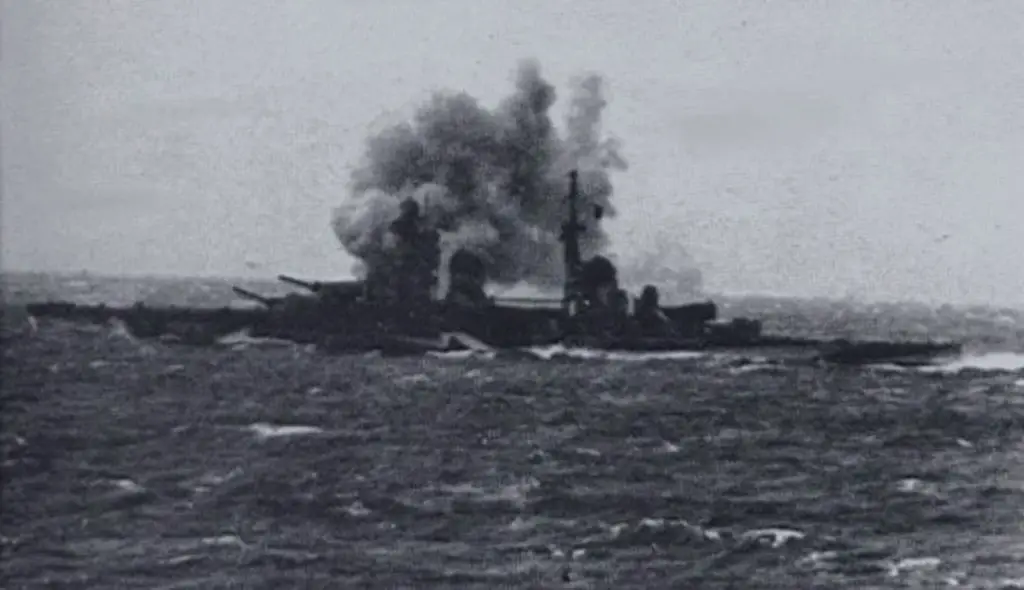
Gorizia firing on Royal Navy Destroyers in the Second Battle of Sirte on 22 March 1942.
At 4:30 P.M., the opposing fleets again made sight of each other. The Euryalus and the Cleopatra were both peppered by Italian shells. The winds began to increase to Gail force strength and coupled with the smokescreen, it became difficult for the Italian ships to get into position to fire. Once the Vittorio Veneto found a clearing, it badly damaged two Allied destroyers (one had reduced speed, the other temporary crippled in the water). With the worsening of conditions and slight damage to the Vittorio Veneto, Admiral Iachino disengaged the attack.
The Lanciere and Scirocco sink from the Gail off Sicily.
Mareth
March – Italian forces inflict heavy losses on British 56th division.
MALTA
There were 275 air raids in Malta for the month of March. Ninety of them at night.
April 1942
Mediterranean
April – 283 air raids occurred in Malta this month and the island absorbed 6,728 tons of bombs. Thanks to limestone houses, and the ability of the British to defend Malta, the Maltese continued to handle the attacks well.
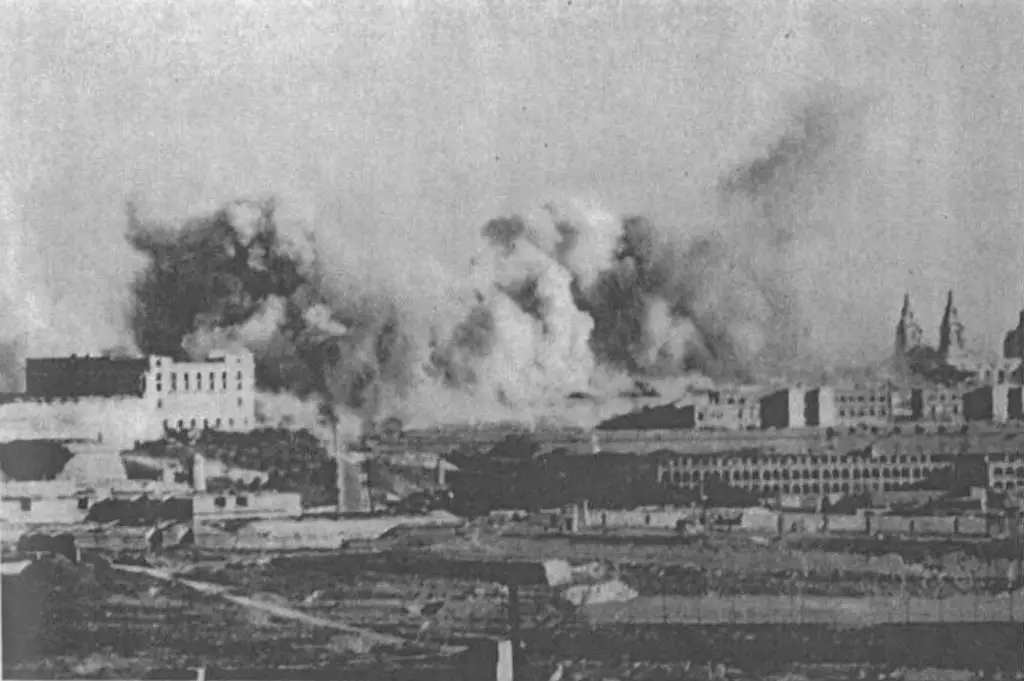
Malta as it is being bombed on 24 April 1942.
01 April – British submarine HMS Urge sinks Italian cruiser Giovanni Delle Bande Nere near Stromboli.
14 April – Italian Torpedo Boat Pegaso sinks the highly respected British submarine HMS Upholder off the coast of Tripoli, Libya.
28 April – Italian Torpedo Boat Pegaso sinks British submarine HMS Urge off the coast of Libya.

Torpedo Boat Pegaso.
Enfidaville
29 April – Italian forces inflict considerable losses on the British 56th Division as soon as it reached the battlefield.
May 1942
Libya
05 May – The Italian Comando Supremo (head of all Axis forces in Africa), orders Rommel to stop his advance in Egypt in order to concentrate all Italo-German forces on Operation Hercules. After heavy arguments between Italian and German command officials, Comando Supremo reluctantly postpones Operation Hercules.
26 May – Trieste makes its way through British minefields and the Ariete destroy the III Indian Motor Brigade and hold the IV Armored Brigade because the German 90th Light proved too weak to both attack and guard the Axis flank.
Battle of Gazala
26 May to 21 June – The Battle of Gazala: One of the high points of Rommel’s African military tactics in which Auchinleck and Ritchie could not take advantage of the situation. As a result, the British 8th army is beaten back.
27 May – Italian troops attack Bir Hacheim. Rommel’s Axis forces reach 10 miles behind the Gazala line. Italian engineers open a supply line in the west to Rommel’s forces.
28 May – DAK runs out of fuel. The Ariete and Trieste divisions overrun British positions to assist the DAK. On the 28th and 29th of May, Italian X Corps open up supply lines through the British minefields.
29 May – British submarine HMS Turbulent sinks Italian destroyer Emanuelle Pessagno off the coast of Libya.
Libya
31 May – Italian guns inflict heavy losses on the British near Sidra Ridge. The Ariete pound the II and XXII Armored Brigade. General Ettore Bastico reports:
[wpsm_quote author=”General Ettore Bastico” float=”none” width=”100%”]The Italian XX Corps fought well, the DAK, not so well. The 90th Light was in retreat.[/wpsm_quote]
June 1942
01 June – Rommel’s Axis forces break through the Gazala line, destroying 100 British tanks and taking 3,000 British POW’s.
05 – 06 June – British Commonwealth forces mount a major counteroffensive code-named “Aberdeen”. The Italian X Corps holds them up in the North and the Trieste and 90th Light contain the French at Bir Hacheim. The Ariete joins the 15th and 21st Panzer to battle the 42nd and 7th Royal Tank Regiments, including the II, IV and XXII Armoured, IX and X Indian and the CCI Guards brigades. The Italo-German forces repulse the British at Sidra and Aslagh ridges. Approximately 6,000 commonwealth forces are killed or wounded, 150 tanks lost and 4,000 POW’s are taken between 5-6 June.
07 June – Italian forces rescue the German XV Brigade near Gazala.
Mediterranean
08 June – Italian submarine Alagi sinks the Italian destroyer Antonio Usodemare by tragic mistake.
LIBYA
09 June – Axis forces in Africa are low on ammunition and over 50% of their artillery and armor are destroyed. Italian forces strip the Littorio division to make the Ariete battle-ready.
11 June – Bir Hacheim falls to an attack by the Trieste and the 12th Ariete pepper the XXII Armoured and CCI Guard brigades. After a decisive victory, the Ariete attack the IV Armoured Brigade with the 21st Panzer.
Mediterranean
June – The British launch Operation Harpoon to supply Malta from Gibraltar under the command of Vice-Admiral A.T.B. Curteis in the flagship Kenya. The British force consisted of two aircraft carriers, three cruisers, eight destroyers, five freighters, one minelayer (Welshman) and one tanker.
14 June – Operation Harpoon: The Regia Marina sends the Italian 7th cruiser division (cruisers, submarines and torpedo bombers) under Admiral da Zara in the flagship Eugenio di Savoia from Palermo, Sicily to intercept. In the following battle, the Regia Marina’s direct attack sank the British destroyer Bedouin and forced an altered and delaying route on the British. This allows Axis air forces to reduce the convoy from six to two transports. Only two merchant ships, the Orari and Troilus, along with the Welshman, are able to make it to Malta.
15 June – British Submarine HMS Umbra sinks Italian cruiser Trento off Malta.
Mid-June – Operation Vigorous, which included 11 merchant ships, seven cruisers, and 28 destroyers was the largest convoy to set sail for Malta. The convoy turns around and returns to Alexandria, Egypt after obtaining information that Italian Battleships Littorio and Vittorio Veneto, along with two heavy cruisers, two light cruisers, and 12 destroyers are en route to intercept them.
These two operations are major Italian naval victories. However, the downfall is that oil shortages became too great for the Italian military. In short, large Italian naval operations are rarely seen again.
LIBYA
20 June – The Africa Corp and Italian XX Corp begin pounding Tobruk, eventually resorting to hand to hand combat with the British who are under the command of Klopper. Italian Caproni’s, German Junkers 88’s, and Stukas bomb Tobruk to mercy.
21 June – Klopper surrenders Tobruk to the Afrika Korps. The spoils include 33,000 POW’s, roughly 2,000 vehicles, 30 tanks, 400 guns, and much-needed fuel. Italian destroyer Strale runs aground off Tunisia and is scuttled. Rommel persuades Hitler to approve and advance to Egypt. Cavallero, Kesselring, and Mussolini do not agree with his actions.
June – Benito Mussolini receives word that Rommel’s Axis forces are on the verge of capturing Alexandria and Cairo in Egypt. However, the Ariete is reduced to 10 tanks, 24 guns, and 1,500 infantry. The Littorio has 30 tanks, 11 guns, and 1,000 Bersaglieri, the X Corps (Brescia and Pavia) only 2,000 men and 90 guns, the XXI Corps (Trento and Sabratha) only 3,000 men and 100 guns. DAK added another 90 tanks, a few infantry, and a handful of guns.
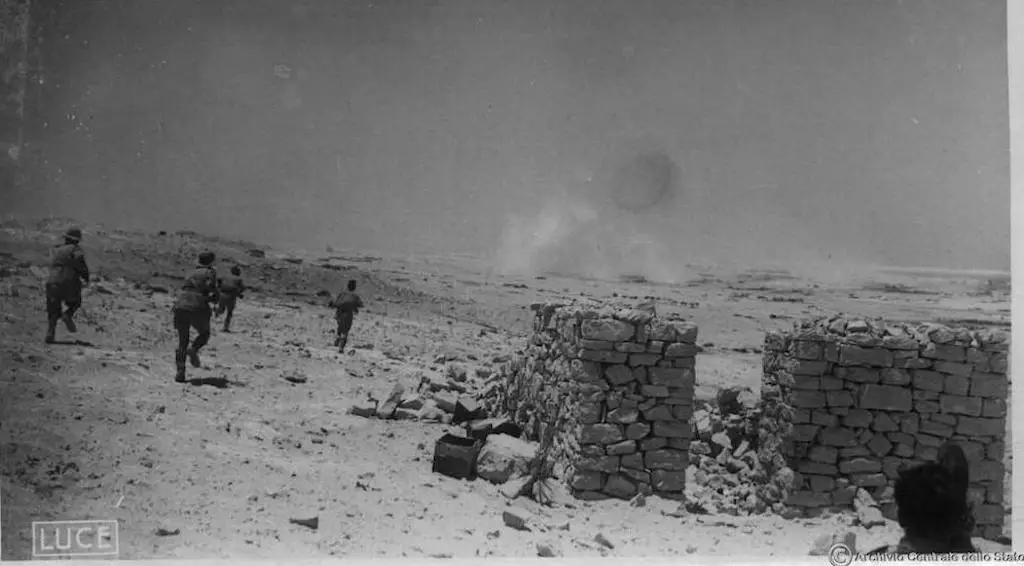
Regio Esercito in action, June 1942, Mersa Matruh.
Egypt
28-29 June – Afrika Korps captures Mersa Matruh. Axis supply lines in Africa stretch 400 miles beyond Sollum and 800 miles from Benghazi.
29 June – Mussolini flies to Tripoli to observe the conquest of Egypt. Rommel’s forces become deadlocked with the Allies in El Alamein, Egypt.
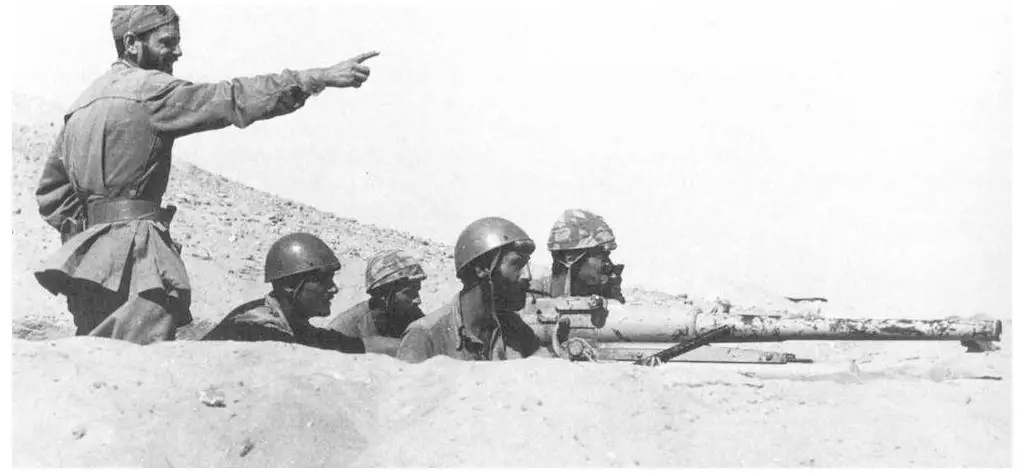
Folgore preparing to fire artillery during the first battle of El Alamein.
July 1942
Soviet Union
July – The Italian army in the Soviet Union increases to a 200,000 man army.
Afrika Korps
03 July – The Ariete are mauled by the I and VII Armoured Brigades and the New Zealand Division (two days after the 90th Light panicked and withdrew.)
Malta
10 July – Planned date of Operation Herkules, the invasion of Malta.
Egypt
11 July – The British overrun the 382nd German regiment as well as part of the Trieste and Sabratha.
Middle of July – Folgore Parachute Division under the name of 185th “Cacciatori d’Africa” (Hunters of Africa) arrive at the North African front. They occupy the extreme southern end of the Italo-German deployment, an area between Deir el Munassib and Qaret el Himeimat heights.
19 July – Mussolini writes to Cavallero understanding the exhaustion of Axis forces in Africa and that they were too weak to overrun the British at El Alamein earlier in the month. Mussolini orders a future attack to be prepared by assembling all Axis artillery in Africa and made available to Rommel, with as many “Semoventi” to adjust for the obsolete M14s. The Bologna, Giovani Fascisti, Folgore, Pistoia and Brennero divisions will go to the front. The ports of Tobruk, Sollum and Marsa Matruh as well as the Sidi Rezegh-Marsa Matruh railroad to supplement Axis trucking.
Mussolini also orders the Headquarters to move closer to the front to boost morale.
Italy
21 July – Mussolini flies back to Italy, never to witness the conquest of Egypt. His health failing, many begin to fear the collapse of the Fascist state in Italy.
Siwa, Egypt
Italian forces advance to Siwa. Rommel notes that “If the Italians needed the German before, by mid-July, the German formations [were] much too weak to stand alone.” Rommel considers a retreat, only to be pressed on by Cavallero and Bastico, who are enjoying the Italian successes.
22 July – Trento, Brescia and Ariete capture 1,400 British POW’s and destroy 146 tanks in an unsuccessful British strike.
27 July – The Axis supply crisis ends and the Trento artillery destroys 27 tanks, 30 vehicles and capture 1,000 POW’s during an Axis counterattack after the 9th Australian and I Armored Brigades overran the Trento 61st Battalion and the German 361st Regiment. The British are now just as exhausted. The Italian XX Corps maul the New Zealanders, thanks mostly to Italian artillery and mines which destroy 86 of the XXII Armored Brigade’s 97 Valentines and 120 New Zealand anti-tank guns.
End of July – The British try to break through the Folgore Parachute Division at Deir el Munassib. However, Folgore’s strong defense repel the attack and cause the British substantial losses in men and vehicles.
August 1942
Russia
August – Russians near Serafimovich launch a counterattack against the Italians holding the Don River in the hope of holding back the advances to Stalingrad. The Italians are outnumbered yet told to stand their ground and fight to the end. They eventually beat back the Russian tanks with Molotov cocktails. The battle in Serafimovich cost the Italians 1,700 men, but capture 1,600 Russian POW’s and many small arms.
Mediterranean

The tanker Ohio hit by a torpedo from the Italian submarine Axum during Operation Pedestal.
02 August – The most important convoy sets sail for Malta. Operation Pedestal involves a 14 ship convoy desperately needed to keep Malta alive.
06 August – Italian Torpedo Boat Pegaso sinks British submarine HMS Thorn off Tobruk, Libya. (Note: Pegaso sinks three British submarines in 4 months.)
13 August – Operation Pedestal concludes with the arrival of 4 merchant ships in Malta. Malta is saved.
Egypt
13 August – General Bernard Law Montgomery assumes command of the British Commonwealth forces Eighth Army.
Mediterranean
22 August – Italian torpedo boat Antonio Cantore sinks after hitting a mine.
Soviet Union
24 August – With the victory in Serafimovich, the Italian Savoia Cavalry made up of 600 men mounted a counter-attack on the Isbuschenski steppe. The Russian’s comprised of 2,000 men with mortar and artillery support. One squadron attacked head-on, while the other came behind the enemy lines on horseback and possessing only sabers. They completely catch the Soviets by surprise and overrun the Russian position.

Savoia Cavalleria regiment commanded by Colonel Alessandro and Count Bettoni Cazzago.
This is one of the last cavalry attacks of World War II. The results include the destruction of two Soviet battalions, another battalion forced to withdraw, the netting of 500 POWs, four large artillery pieces, 10 Mortars, and 50 machine guns.
Egypt
30 August – Rommel loses 49 tanks in Alam el Halfa Ridge to the British.
A large Italian supply effort delivers Rommel 67 infantry battalions (39 being Italian), 536 guns (336 Italian), 515 tanks (281 Italian), 119 armored cars (72 Italian) and 777 aircraft (427 Italian). Since the 26th of May, Italian casualties amount to 9,568 and German casualties are 12, 430.
September 1942
03 September – Rommel receives another 2,450 casualties, lost 50 guns and 400 AFV’s. About 10,000 tons of fuel is used up. Cavallero sees disaster around the corner. Rommel uses up all his fuel and reinforcements and adopts Marshall Graziani’s “Capisaldi” (strong points) used in 1940 for the very same reasons; too weak to attack, no resources for a mobile defense and an order not to retreat. A final stand is set for El Alamein.
Mediterranean
04 September – British bombers sink Italian torpedo boat Polluce off Tobruk.
Libya
13-14 September: Hundreds of Allied men were wounded, captured, or killed, along with several Royal Naval vessels sunk following Operation Agreement, the failed British attack against Tobruk utilizing land and amphibious forces.
October 1942
Italy
11 October – Heinrich Himmler flies to Rome to visit Mussolini. The German government is very worried about the health of Mussolini. Himmler’s visit was to assess Mussolini’s health and the state of Fascism in Italy. Himmler later reports back to Hitler that if Mussolini remains alive, then so will the Fascist state.
Mediterranean
19 October – British submarine HMS Unbending sinks Italian destroyer Giovanni da Verrazzano off Tripoli.
Egypt
23 October – British 8th Army under command of General Montgomery attacks El Alamein. The 12 Italian and German divisions amounted to 80,000 men (53,000 of which were Italian). The Commonwealth forces amounted to 230,000 men divided among 10 divisions. The following table shows the superiority of the Allies in numbers. As far as the tanks are concerned, only the German Panzer IV (35 total) were equal to the Commonwealth’s American Sherman (252 total )and Grant (170 total) tanks.
| Forces | Commonwealth | German | Italian |
|---|---|---|---|
| Troops | 230,000 | 27,000 | 53,000 |
| Aircraft | 1,500 | 350 | 430 |
| Artillery | 2,311 | 618 | 850 |
| Tanks | 1,230 | 210 | 280 |
El Alamein
23-29 October – The British attack the sector defended by the Folgore Parachute Division. The Italian forces included 3,500 paratroopers, 1,000 Guastatori d’Africa, 80 artillery pieces and five tanks of German origin. The odds were 1:13 for men, 1:5 for Artillery and 1:70 for tanks. The Folgore prepare their defenses among a 15-kilometer barrier and realized they were the last defense before the rear of the Italo-German Army. The fighting lasts one week and constitutes four separate battles; the central sector on the 23rd, the northern sector near Naqb Rala on the 24th, the central sector again on the 24th and 25th, and the southern sector on the 25th, 26th, and 29th.
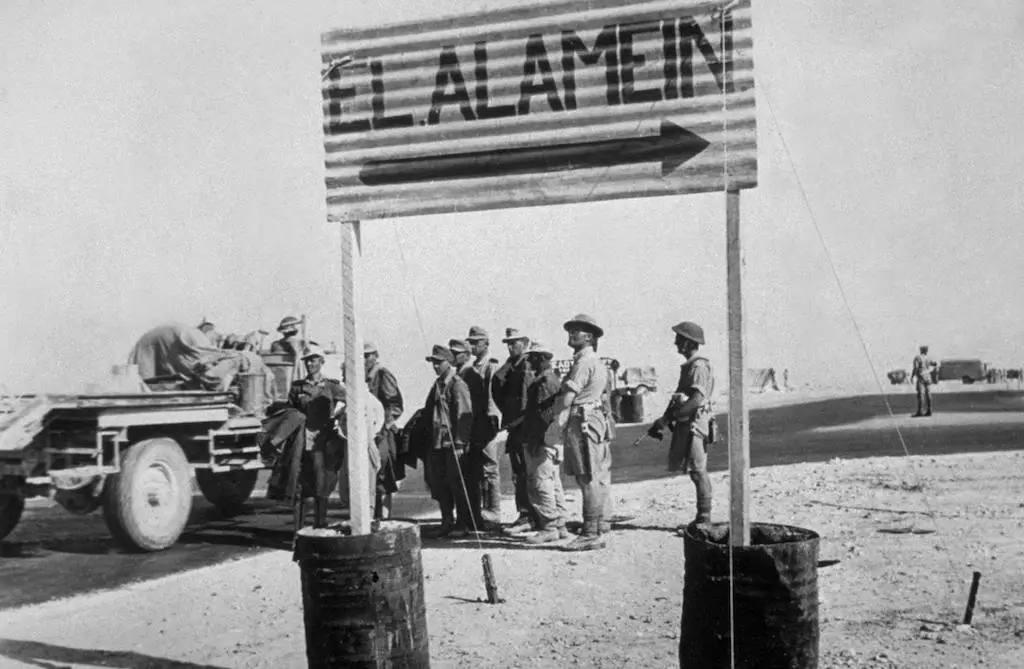
German prisoners under a sign for El Alamein.
The British are thrown back after every attempt with a considerable loss of life. The Folgore are ordered a stop any further initiatives on that front. Total dead, wounded or missing amount to 1,100 for the Folgore. Eventually, General Montgomery’s forces claim victory over the Axis in El Alamein. Rommel orders the Folgore to withdraw on the 2nd of November, leaving their defenses still intact. Eventually, the remaining Folgore forces thin out during the difficult withdrawal through the desert.
Related: Second Battle of El Alamein
November 1942
01 November – General Giovanni Messe leaves Russia
04 November – Rommel’s Axis forces are forced to retreat from El Alamein. Italian soldiers withdraw on foot through the desert. About 16,000 Italians are captured in 14 days. Rommel loses 32,000 men, 1,000 guns and 450 tanks. The Afrika Korps now only consists of 35 German tanks and almost 100 obsolete Italian tanks. British Commonwealth Forces lose 13,500 troops but win in a decisive victory over the Axis Forces.
British bombers sink Italian torpedo boat Centauro off Benghazi.
Africa
08 November – Operation Torch is underway. 107,000 Allies, mostly Americans, land in Casablanca, Oran, and Algiers. In fear of Rommel getting outflanked, Axis air and ground units are routed to Tunisia. They eventually number 250,000 troops.
Mediterranean
27 November – Italian torpedo boat Circe accidentally rams a merchant vessel it is escorting and sinks off the coast of Sicily.
Toulon, France
27 November – Two German columns roll into Toulon to take possession of all French ships. Forewarned, Admiral Jean de Laborde orders his fleet scuttled. He ensures all ships scuttled will rest on even keels in the hope that someday they can be salvaged to sail for France again. A total of 77 ships rest on the bottom of the sea at the port of Toulon. It was not the French, but Italian engineers who are the first to salvage the ships. In nine months, Italian engineers are able to salvage 30 ships. Italy confiscates the 30 vessels along with everything salvageable above the waterline. Some items confiscated are the aircraft catapult and turret armor of the Battle Cruiser Strasbourg, and the interior fittings of the Dunkerque. Seven French destroyers and one submarine are either towed or sail on their own power to ports in Italy.
December 1942
02 December – British Force Q sinks Italian destroyer Folgore off Tunisia.
British bombers sink Italian torpedo boat Lupo off the coast of Greece.
04 December – U.S. bombers sink Italian cruiser Muzio Attendolo in the port of Naples.
Soviet Union
Mid-December – Axis forces begin losing ground in the Soviet Union. Russian troops mount a counterattack on the frozen Don River. Fierce fighting is reported. Eventually, the Hungarian and Romanian forces flee, leaving only the Italians to fight. Outnumbered 4-1, Italians are forced to retreat leaving only crack Alpine troops to fight until they too are almost encircled.
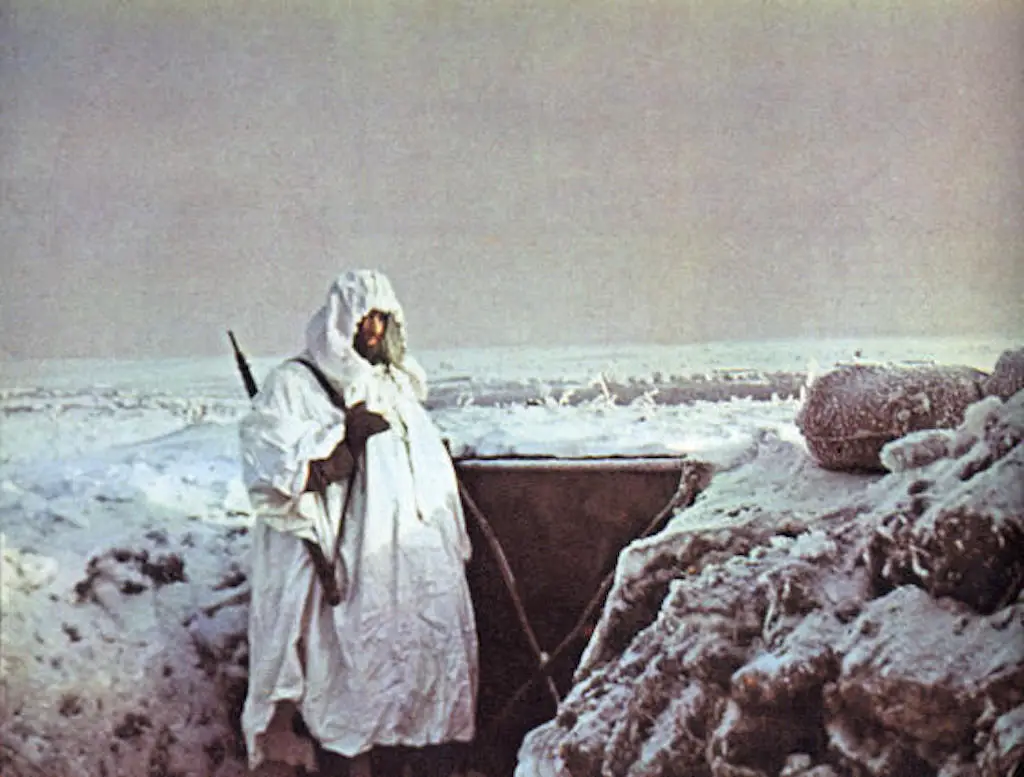
An Alpino in Russia.
Germany
16 December – Mussolini realizes that a 2 front war is un-winnable. He sends Conte Ciano to meet with Hitler to discuss a possible peace settlement with Russia. Hitler discounts this proposal and claims that the Axis can win a 2 front war.
17 December – U.S. bombers sink Italian destroyer Aviere near Palermo.
Mediterranean
25 December – Italian Torpedo Boat Ardente sinks British submarine P48 off the coast of Tunisia.